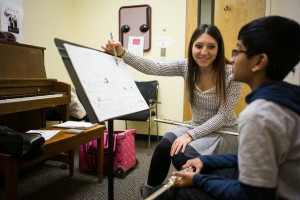 I’ve been a professional musician, a music teacher or a college music professor most of my life, and I didn’t learn how to practice efficiently until a few years ago.
I’ve been a professional musician, a music teacher or a college music professor most of my life, and I didn’t learn how to practice efficiently until a few years ago.
Therefore, it is safe for me to conclude that there are also many teachers out there who don’t know how to effectively practice or teach how to do so properly. This obviously trickles down to students, who then struggle to improve and don’t know why they are not getting better — and then to parents, who have no idea how to help their child.
Luckily, it is easy for anyone to craft a great practice session. You don’t need a musical background to succeed at this. If parents spend a minimal amount of time helping their child out in the beginning stages of their musical instruction, there is a great chance that the child will continue playing throughout their school life and reap all the amazing benefits music education has to offer.
Here’s how parents can help create a perfect practice session for their child:
- Designate a practice spot in the home. Ideally, parents should carve out a semi-quiet area with a chair and a sturdy music stand. There should be proper lighting and a place to store extra strings, rosin, music, pencils, markers, notebook and a metronome. There should be minimal distractions such as TV, radio, other children, pets or telephone. My kids’ practice spot is right in our living room.
- Figure out your child’s “perfect practice time.” If your child feels freshest in the morning, early morning practice may be the way to go. If their energy peaks in the afternoon or at night, have them practice then. Whatever time you choose, be consistent and try to have your child practice at the same time five or six days a week.
- Write down goals for the practice session. Let’s say two students practice every night for the same amount of time. Student 1 practices with the intention of “getting better”, while student 2 begins practicing with specific goals and a time frame for achieving the goals in mind. It’s pretty obvious which student has a better chance of improving! Goals can be written down in a practice log or on a napkin — it doesn’t matter, at first. A sample goal could be “I will play the first 2 measures of Go Tell Aunt Rhody three times without mistakes”, or “I am going to learn to play two new notes”.
- Use the “10 Minute Rule.” 10 minutes of practice a day is better than nothing, and 99% of the time 10 minutes turns into 20 minutes! As long as your school music teacher gives clear assignments, ten minutes will extend to a half an hour easily without your child even realizing it.
- Practice Deliberately. The sooner a child learns how to practice, the better! Without guidance, most people tend to practice one of two ways:
- The Loop Method. This is where we simply repeat the same thing over and over. It might sound like practice, but it is simply mindless repetition — and it doesn’t work.
- Autopilot Method: This is where we activate our autopilot system and coast. A student runs through a piece from beginning to end — wash, rinse, repeat — and nothing is learned.
Deliberate practice is a systematic and highly structured activity. Instead of mindless trial and error, it is an active and thoughtful process where we seek solutions to clearly defined problems.
Deliberate practice is often slow, and involves repetition of small and very specific sections of a skill instead of just playing through. For example, instead of playing an entire 8 measure exercise beginning to end, the child would practice the first four notes in order to make sure that they are in rhythm and sound beautiful. They can then practice the next four notes in this (or another) practice session, then connect all eight notes together.
Deliberate practice ensures that the child figures out why mistakes happen. Why did they miss the third note they played? Were they going too fast? Were their fingers not in the right place? Do they even know what the note name is yet? Deliberate practice gives the child the time to figure out the answers to these questions.
This may sound like a lot of work, but it does not need to be. Children who spend 10 minutes a day thinking like this are the ones who find success in all of their subjects. To stop, analyze what went wrong, why it happened, and how they can produce different results the next time is an amazing skill to have — and anyone can learn to think and practice this way.
Again, it took me decades to figure this out, but it is the most valuable lesson I learned in my life and a lesson I am passionate about sharing with students and parents.
Some other practice tips:
-
Use a metronome. Buy one or download a metronome app immediately! Students should set the metronome at a slow tempo at first, then gradually increase the pulse until they arrive at the final tempo over the course of the week.
-
Use a pencil. Students should make good use of pencil and markers to indicate places where they keep making the same mistake. When a mistake is made, a mark needs to be written in pencil on the music in order for your child to remember to pay attention to that spot.
-
Record your practice session. A digital recorder or phone is a great tool to use when practicing. Students can record themselves playing so they can hear problems, particularly regarding to rhythm and notes. This is a lot of fun for them to do, so encourage it!
Practice sessions should end by playing a piece that the student knows well and has fun playing — or anything they want, really. Always end a session on a positive note, so to speak.
If parents pay close attention to creating a “perfect practice session” for the first month their child begins studying an instrument, they will be surprised to see how self-motivated and independent their child becomes. They will soon develop their own good practice habits without needing much guidance. Meanwhile, it’s the parent’s job to ensure practice happens daily — at least 5 days a week.
In our culture of immediate gratification, it’s important that students have the tools to quickly improve on their instruments so they don’t become frustrated or bored and choose to quit. Practicing smart — not long — is a skill that is transferable to any subject in school, and music instruction is the best vehicle to teach this.
Do you have any great practice advice to share? Leave a comment below!








I agree that learning how to practice is a valuable skill! My daughter has a new private teacher that has helped her learn how to practice. Any time she has a new piece she is learning she breaks it down into sections. Only reviewing one section at a time. She circles areas where she needs to practice and gives her exercises for homework for the week, practicing 20 minutes a day.
My daughter has joined a youth orchestra and participates in a chamber music group. Both of these require practice and she is accountable to her peers. All of it has helped her to be come more efficient with practice time. She doesn’t want to let down her group by not being prepared.
A student can work on technical passages by playing them as different rhythms. For instance, if a passage is in 16th notes, they can a dotted 8th/16th note pattern (or vice versa) for each two 16th notes.
Another really good drill for keeping time/rhythm is to sub-divide. You can have the student find the the smallest rhythmic value in their music (say an 8th note) and play that passage based upon that rhythmic value getting the beat. So, for instance, if they choose the 8th note, then the whole passage can be practiced with the 8th note getting the beat. If they choose a 16th note, then THAT gets the beat.
I am a teenage violinist. I really needed to read this! Thank you for all the helpful tips. My goal is to practice two hours per day, but sometimes my day is too busy to get that much practice in so I don’t even start practicing! I take big steps backward when I don’t touch my violin for several days in a row. After reading your post, I feel motivated to reassess my practicing habits and learn how to practice better!